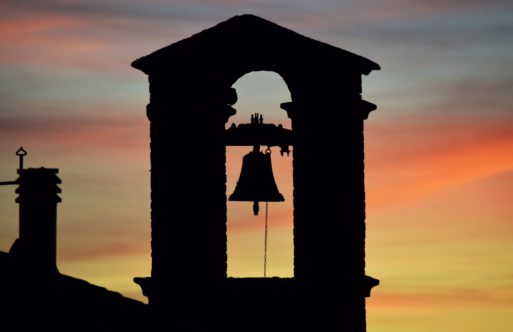
The Death Knell — it’s a term we’ve all heard used to describe events that signal the coming end of things. Just today I read an article proclaiming video streaming services to be the death knell of the cinema industry. While commonly understood, this meaning of the term death knell is not exactly the same as the original English Death Knell, and it gives us a great opportunity to take a look at this ancient tradition and what it meant as far back as the 16th century. (And it wasn’t the world’s first metal band, sorry).
Church Bells Often Meant Death
The Death Knell was the second in a series of three bells that announced the end of a person’s life. The Death Knell, traditionally rung upon death, was preceded by the “Passing Bell” and followed by the “Corpse Bell” (which has evolved into the modern Funeral Toll). The Passing Bell would have chimed as the person lay dying, the Death Knell at the time of death, and the Corpse Bell, or “Lych Bell,” rung as funeral processions neared the churchyard.
The timing of these bells gave communities information about the dead, but the manner of their ringing also communicated important facts about the person who died. For example, in some instances, the number of chimes signified the age of the dead person.
Another, more common practice was the use of “Tellers.” Tellers were repetitive patterns of strokes that told if the dead person was male, female, or child, and different patterns were used in different parts of England. It’s also interesting to note that though these are somewhat localized interpretations, the ringing of bells at the end of life is a tradition outlined in Church of England Canon Law and was regulated by statute in Elizabethan England by Henry VIII and Elizabeth I.

The Bells at Westminster Abbey
Credit: westminster-abbey.org
Half-Muffled Bells Still Ring in Memorium
The Death Knell is also traditionally associated with the ringing of half-muffled bells. This is achieved by covering half of the bell’s clapper with a leather muffle and results in bells “reciprocating” between a harder, sharper chime and a softer, muffled chime. It’s a haunting sound, especially in cacophony, and it’s become common at modern funerals — perhaps most notably at Princess Diana’s funeral in 1997. The Bells at Westminster Abbey are the most well-known bells to chime in this way. You can see a good example of half-muffled bells being rung for the reading of the “Roll of Honour” for Armistice Day in the video below.

 The Tolling of the Death Knell
The Tolling of the Death Knell


 Recovering Cremation Remains After the Los Angeles Fires
Recovering Cremation Remains After the Los Angeles Fires
 “As Tears Go By” by Marianne Faithfull
“As Tears Go By” by Marianne Faithfull
 “The Sea” by John Banville
“The Sea” by John Banville














